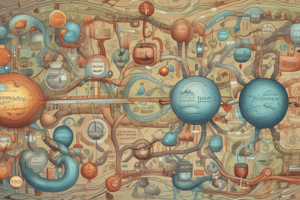Podcast
Questions and Answers
What is the result of the energy released by the transfer of electrons in the electron transport chain?
What is the result of the energy released by the transfer of electrons in the electron transport chain?
- The conversion of glutamate to α-ketoglutarate
- The creation of an electrochemical gradient across the mitochondrial membrane (correct)
- The synthesis of ATP from ADP + Pi
- The removal of N from the α-amino group of amino acids
What is the role of ATP Synthase in the electron transport chain?
What is the role of ATP Synthase in the electron transport chain?
- To synthesize ATP from ADP + Pi (correct)
- To remove N from the α-amino group of amino acids
- To pump protons into the intermembrane space
- To convert glutamate to α-ketoglutarate
What happens to surplus amino acids in the body?
What happens to surplus amino acids in the body?
- The N from the α-amino group is removed and the remaining carbon skeleton is further metabolized (correct)
- They are converted into glucose
- They are excreted in the urine
- They are stored for later use
What is the process of removing N from amino acids called?
What is the process of removing N from amino acids called?
Which amino acid undergoes a meaningful level of deamination in humans?
Which amino acid undergoes a meaningful level of deamination in humans?
What is the result of transamination in most tissues?
What is the result of transamination in most tissues?
What is the energy currency of the cell?
What is the energy currency of the cell?
What is the location of the electron transport chain?
What is the location of the electron transport chain?
What is the role of protons in the electron transport chain?
What is the role of protons in the electron transport chain?
What is the organ responsible for removing N from the body?
What is the organ responsible for removing N from the body?
Flashcards are hidden until you start studying
Study Notes
Metabolism
- Metabolism involves two main types of processes: catabolism (breakdown of molecules, names end in 'lysis') and anabolism (synthesis of molecules, names end in 'genesis')
- Catabolism generates ATP and NADH, mostly in the mitochondria
- Anabolism uses ATP, GTP, UTP, mostly in the cytosol
Why Metabolic Pathways are Complicated
- Metabolic pathways release energy in small, usable 'packages' through stepwise breakdown
- Pathways can be regulated by regulating specific enzymes
- Different 'forward' and 'reverse' pathways allow for separate regulation
Regulation of Metabolic Pathways
- Activating enzyme 1 (and/or enzyme 2) would speed up forward and reverse pathways, creating a 'futile cycle'
- Activating enzyme 1 speeds up forward pathway
- Activating enzyme 3 speeds up reverse pathway
Activated Carrier Molecules
- Energy released at each step is stored in activated carrier molecules
- Examples of activated carrier molecules: ATP, NADH, FADH2, Coenzyme A/acetyl CoA
Importance of ATP
- ATP is the energy currency of the cell
- ATP is chemically stable at pH 6-9
- ATP has structural features recognized by specific proteins, enzymes, etc.
- Hydrolysis of ATP gives ADP + Pi, releasing energy available for cellular work and chemical synthesis
ATP Hydrolysis
- ATP hydrolysis is energetically favorable, with a ΔG of -31 to -50 kJ/mole
- ATP hydrolysis is a controlled release of energy
Introduction to Metabolism
- Learning outcomes: define metabolism, anabolism, and catabolism; give examples of anabolic and catabolic pathways; explain controlled release of energy; outline the role of activated carrier molecules; recognize the general roles of NAD/NADH, NADP/NADH, FAD/FADH2, Coenzyme A/acetyl CoA; explain the key function of ATP as the 'energy currency of living cells'
The Electron Transport Chain
- The electron transport chain generates an electrochemical gradient by pumping protons (H+) into the intermembrane space
- Protons flow back through the membrane via ATP Synthase, driving the synthesis of ATP from ADP + Pi
Amino Acid Metabolism
- Amino acid metabolism is complex and varied, but involves the removal of nitrogen (N) from amino acids
- Deamination: removal of N from amino acids, mainly occurring in the liver
- Transamination: conversion of one amino acid to another, mainly occurring in most tissues
Studying That Suits You
Use AI to generate personalized quizzes and flashcards to suit your learning preferences.




